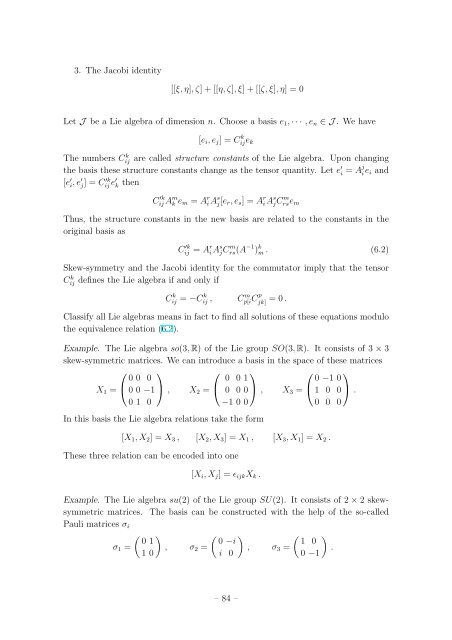Student Seminar: Classical and Quantum Integrable Systems
Student Seminar: Classical and Quantum Integrable Systems
Student Seminar: Classical and Quantum Integrable Systems
Create successful ePaper yourself
Turn your PDF publications into a flip-book with our unique Google optimized e-Paper software.
3. The Jacobi identity<br />
[[ξ, η], ζ] + [[η, ζ], ξ] + [[ζ, ξ], η] = 0<br />
Let J be a Lie algebra of dimension n. Choose a basis e 1 , · · · , e n ∈ J . We have<br />
[e i , e j ] = C k ije k<br />
The numbers C k ij are called structure constants of the Lie algebra. Upon changing<br />
the basis these structure constants change as the tensor quantity. Let e ′ i = A j i e i <strong>and</strong><br />
[e ′ i, e ′ j] = C ′k<br />
ij e ′ k then C ′k<br />
ij A m k e m = A r i A s j[e r , e s ] = A r i A s jC m rse m<br />
Thus, the structure constants in the new basis are related to the constants in the<br />
original basis as<br />
C ′k<br />
ij = A r i A s jC m rs(A −1 ) k m . (6.2)<br />
Skew-symmetry <strong>and</strong> the Jacobi identity for the commutator imply that the tensor<br />
C k ij defines the Lie algebra if <strong>and</strong> only if<br />
C k ij = −C k ij , C m p[iC p jk] = 0 .<br />
Classify all Lie algebras means in fact to find all solutions of these equations modulo<br />
the equivalence relation (6.2).<br />
Example. The Lie algebra so(3, R) of the Lie group SO(3, R). It consists of 3 × 3<br />
skew-symmetric matrices. We can introduce a basis in the space of these matrices<br />
⎛<br />
0 0 0<br />
⎞<br />
⎛ ⎞<br />
0 0 1<br />
⎛ ⎞<br />
0 −1 0<br />
X 1 = ⎝ 0 0 −1 ⎠ , X 2 = ⎝ 0 0 0 ⎠ , X 3 = ⎝ 1 0 0 ⎠ .<br />
0 1 0<br />
−1 0 0<br />
0 0 0<br />
In this basis the Lie algebra relations take the form<br />
[X 1 , X 2 ] = X 3 , [X 2 , X 3 ] = X 1 , [X 3 , X 1 ] = X 2 .<br />
These three relation can be encoded into one<br />
[X i , X j ] = ɛ ijk X k .<br />
Example. The Lie algebra su(2) of the Lie group SU(2). It consists of 2 × 2 skewsymmetric<br />
matrices. The basis can be constructed with the help of the so-called<br />
Pauli matrices σ i<br />
σ 1 =<br />
( ) 0 1<br />
, σ 2 =<br />
1 0<br />
( )<br />
( )<br />
0 −i<br />
1 0<br />
, σ 3 = .<br />
i 0<br />
0 −1<br />
– 84 –

















